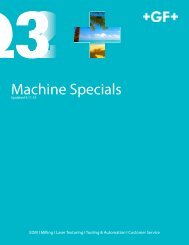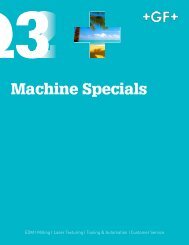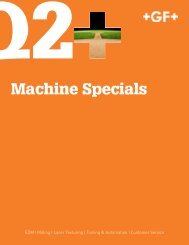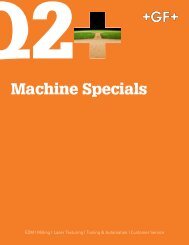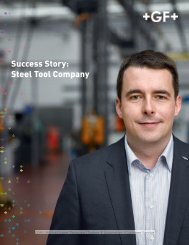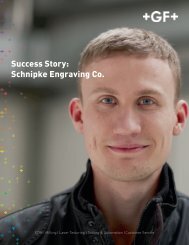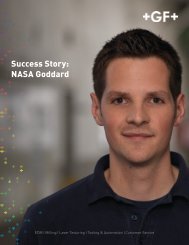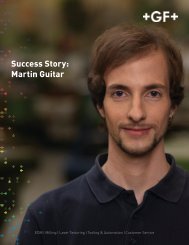Jarvik Heart, Inc.
You also want an ePaper? Increase the reach of your titles
YUMPU automatically turns print PDFs into web optimized ePapers that Google loves.
The machine features the IPG-V generator that increases<br />
pulses’ shape factor while shortening the pulse duration,<br />
allowing it to obtain high accuracy and surface finish. These<br />
areas are also bolstered by the machine’s unique toroids that<br />
activate during taper cutting, which increases the wire tensile<br />
force. The machine provided exactly the results <strong>Jarvik</strong> <strong>Heart</strong><br />
needed and the next challenge was obtaining the machine in<br />
time to produce tangible results prior to the NIH review.<br />
Once the order had been placed, GF AgieCharmilles began<br />
preparations for an expedited delivery. This process uncovered<br />
a significant problem. The opening to the freight elevator in<br />
<strong>Jarvik</strong> <strong>Heart</strong>’s building was approximately 4” narrower than<br />
the width of the AC Classic V2. Given the sensitivity of the<br />
project, GF AgieCharmilles immediately formed a team to address<br />
the challenge. Employees from the GF AgieCharmilles<br />
Refurbishment, Advanced Technical Support and Northeast<br />
Regional Service departments came together to devise a solution.<br />
It quickly became clear that the only option was to disassemble<br />
a machine for delivery and then reassemble it on-site.<br />
An AC Classic V2 was delivered to GF AgieCharmilles’ Lincolnshire<br />
facility, where it was immediately stripped of sheet metal<br />
and peripherals. A team of technicians then disassembled the<br />
machine, carefully identifying and marking every component,<br />
connection and fitting. The machine made the journey to New<br />
York in six crates.<br />
In January 2008, four engineers from GF AgieCharmilles traveled<br />
to <strong>Jarvik</strong> <strong>Heart</strong> to reassemble the machine. A special<br />
hoist was created to aid in the unconventional installation.<br />
After several days, <strong>Jarvik</strong> <strong>Heart</strong> had its new wire EDM, its<br />
condition indistinguishable from a machine fresh off of the<br />
production line.<br />
<strong>Jarvik</strong> <strong>Heart</strong>’s 2008 NIH review went extremely well, with all<br />
parties impressed by the breakthroughs the team had made.<br />
While developed for infants, the new design has potential ramifications<br />
for all those who suffer from life threatening heart<br />
disease. To be effective, the pediatric VAD needed to be able<br />
to increase its output to match the growing body of its host. In<br />
an infant, it would require operation at 20,000 rpm to achieve<br />
the necessary blood flow. As that child grows, the pump’s rpm<br />
increases to drive a greater amount of blood. Initial evaluation<br />
of the new design indicates that the pump is capable of<br />
maintaining 70,000 rpm, pumping enough blood for an adult.<br />
Due to its much smaller size, the new pump could considerably<br />
reduce the risks and complexity of the surgery necessary<br />
to implant a VAD.<br />
“The new model holds tremendous promise,” says Dr. <strong>Jarvik</strong>.<br />
“The fit of the bearings is so perfect that the amplitude of<br />
radial vibrations possible is on the order of 10 to 20 millionths<br />
of an inch. When the pump is running at 70,000 rpm underwater,<br />
it is nearly silent and you can hold it and feel practically no<br />
vibration.”<br />
The pediatric VAD will soon be used in its first animal implants.<br />
If that produces the expected results, a long period of<br />
clinical trials will be necessary. As with all medical devices,<br />
full acceptance and integration of the product will be a lengthy<br />
process due to regulatory hurdles.<br />
“Each improvement to the design of a VAD becomes somewhat<br />
more difficult,” explains Dr. <strong>Jarvik</strong>. “Once we had a<br />
device that proved effective for two years, people then wanted<br />
one that would last for five. Once we cleared that hurdle,<br />
people wanted one that would last for ten. And once one<br />
model receives those results, the regulatory bodies want<br />
every model to achieve those results. In effect, each success<br />
we achieve lengthens the time it will take to develop our next<br />
improvement.”<br />
That challenge does not faze the team of forty employees<br />
working with Dr. <strong>Jarvik</strong>. They recognize that the road to improving<br />
people’s lives will always have significant hurdles to<br />
overcome. For <strong>Jarvik</strong> <strong>Heart</strong>, the reward is worth making the<br />
effort to always strive for the best possible results.<br />
To further aid in meeting the deadline imposed by <strong>Jarvik</strong><br />
<strong>Heart</strong>, applications specialists from GF AgieCharmilles assisted<br />
in development of the complex programming needed to<br />
complete the prototype Dr. <strong>Jarvik</strong> had envisioned. In the end,<br />
the part was completed to the exact specifications required.<br />
“The AC Classic V2 delivered the precision and surface finish<br />
demanded by the part,” says Dr. <strong>Jarvik</strong>. “We have to hold steep<br />
angles within a 0.016º tolerance, while having the machine<br />
provide surface finish of around 0.15 µm. It’s a demanding application<br />
and we couldn’t do it without the innovations found in<br />
GF AgieCharmilles’ wire EDM.”







